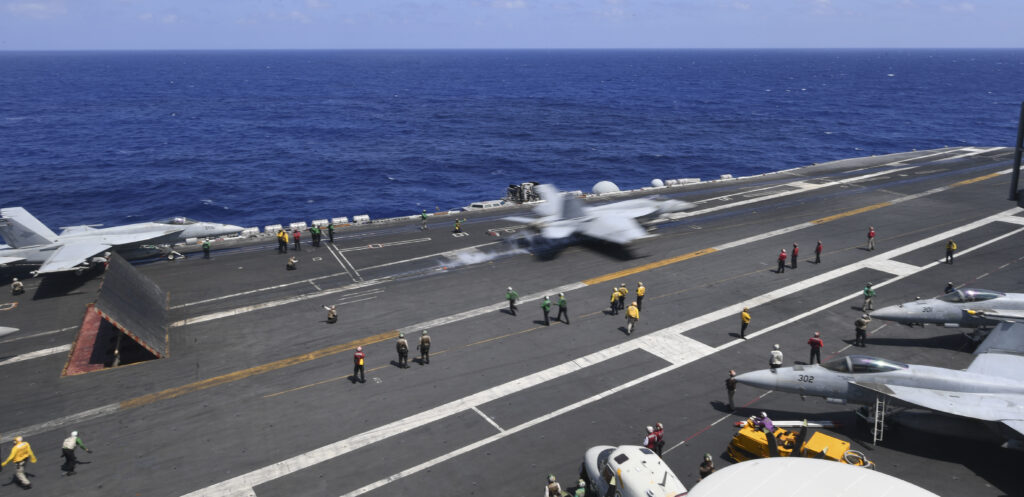
An F/A-18E Super Hornet launches from the flight deck of the aircraft carrier USS Theodore Roosevelt. March 19, 2020. (DoD)
WASHINGTON: Senior naval aviation officials used a Congressional hearing on Tuesday to lay out a series of changes to the fleet’s structure and maintenance plans that they say will close the ongoing strike fighter shortfall four years earlier than anticipated.
“A number of things have changed in the last year as far as [our ability] to meet that shortfall, and, while the points you brought up are accurate, we also have a different mix of aircraft in the fleet going forward,” Frederick “Jay” Stefany, the acting Navy acquisition executive, said during a House Armed Services subcommittee hearing about the Pentagon’s aviation budget request.
The strike fighter shortfall has plagued the Navy’s fleet for years. Service projections from last year, according to lawmakers, showed a 49-plane gap in fiscal year 2021 and 12-plane shortage in FY24. The bottom line was the Navy would not reach its inventory goals until 2029, according to Hondo Geurts, the service’s acquisition executive at the time.
“We are taking this risk until the end — the late 2020s. I think [2029] is when we will get to the full fighter inventory,” he told House lawmakers in March 2020.
However, Chief of Naval Operations Adm. Michael Gilday testified last month to Congress that the service now expects to close the gap by 2025.
Given a variety of aviation procurement cuts in the most recent budget request and no further explanation from the service, Rep. Vicky Hartzler, R-Mo., said the committee was questioning the “accuracy of the Navy’s analysis.”
The new estimate stems from several adjustments made across the fleet, Rear Adm. Andrew Loiselle, the Navy’s top air warfare requirements officer, said in response to questions from Hartzler. He added that the Navy re-calculates its future inventory estimates on an annual basis.
The first change includes reducing the number of F-35C squadrons per carrier air wing from two to one and increasing the number of planes in each unit from 10 to 14.
Another change has the Navy acquiring F-16s from the Air Force and Air National Guard as well as F-5s purchased from Switzerland to substitute for F/A-18 E/Fs that were being used for red teaming exercises.
Loiselle also said Navy maintainers have been able to return 28 Super Hornets to the fleet that had been considered grounded.
Lastly, there is the Navy’s service life modification program for F/A-18E/Fs, in which Boeing is taking Block II planes near the end of their 6,000 hour service lives and upgrading them to the Block III configuration, providing another 4,000 hours of airtime. That program is expected to have capacity for additional aircraft around FY25 to ingest extra Super Hornets if the service’s analysis changes between now and then, according to Loiselle.
In addition to the extended service life, the Block III Super Hornets also have an upgraded targeting system, an additional radio, high-definition video recording and a reduced radar cross section, according to a report from the Pentagon’s chief weapons tester.
At its peak, the Navy projects the SLM program could ingest up to 40 planes per year and bring maintenance times down from 18 months to one year.
A variable in those times, however, is the amount of corrosion damage maintainers ultimately have to fix. Hartzler pointed out the Navy and Boeing are seeing more corrosion damage than expected and questioned how maintenance times could be improved if the planes are in worse states than anticipated.
“Boeing is seeing significantly improved condition in the aircraft that we are now submitting for SLM,” Loiselle responded. “So, with the number of Block II Super Hornets in our current inventory compared to the number of Block II Super Hornets that we intend to conduct SLM on, that allows us some selectivity in those tails that we put through the modification line.”
He added the two modification lines Boeing is running are expected to reach peak production times around FY23. Lastly, the rear admiral said the Navy is striving to reduce costs by using its own crews of maintainers to mitigate corrosion on some planes when plausible.
Another factor the Navy is banking on to close the gap is its still relatively nascent aerial tanker MQ-25A. That unmanned aircraft, which recently achieved its first successful midair refueling during a test flight, is expected to enter the fleet in the mid-2020s and will relieve the Super Hornets of the refueling mission.
In a ‘world first,’ DARPA project demonstrates AI dogfighting in real jet
“The potential for machine learning in aviation, whether military or civil, is enormous,” said Air Force Col. James Valpiani. “And these fundamental questions of how do we do it, how do we do it safely, how do we train them, are the questions that we are trying to get after.”


























